Problematic issue
The aim is to study the influence of emerged or slightly submerged macro-roughness elements (modelling trees or houses in floodplains) on the structure of laterally confined flows (open-channel with a single rectangular cross-section).
Scientific issues
- Variation of the flow structure with the submergence parameter D/h of the macro-roughness elements (D = time-averaged water depth and h = macro-roughness height), for 1<D/h<1.5.
- Influence of the Froude, Reynolds, and Strouhal numbers on the flow structure
- Influence of the streamwise flow non-uniformity on the flow structure (comparison uniform flow / accelerated flow)
- Influence of a longitudinal transition of hydraulic roughness on the flow structure.
- Influence of the bed roughness (smooth bottom vs. rough bottom) on the flow structure.
- Influence of unsteadiness on the flow structure.
Methodology
The experiments are conducted in an 18m x 3m flume, but using only one third of the width (18m x 1m). The cross-section is rectangular, the side walls are made of glass. For the bottom, different hydraulic roughnesses are studied:
- Tree models (wooden cylinders 1 cm in diameter) placed on a smooth bed (glass)
- Tree models (wooden cylinders 1 cm in diameter) placed on a rough bed (dense artificial grass). Tree density: 81 trees/m², with a staggered distribution.
- House models (6.4 cm side PVC cubes) placed on a rough bed (dense artificial grass). Density of houses: 49 houses/m².
The velocity field is measured using an ADV (side-looking probe) or PIV 2D-2C (vertical-longitudinal plane). These flows are also numerically modeled with 2D and 3D industrial or research codes.
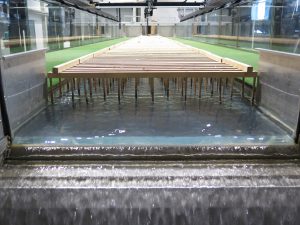 |
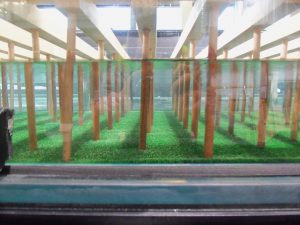 |
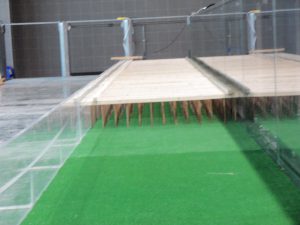 |
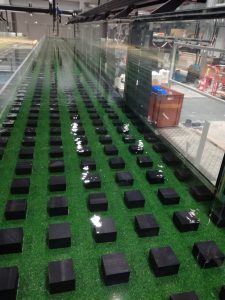 |
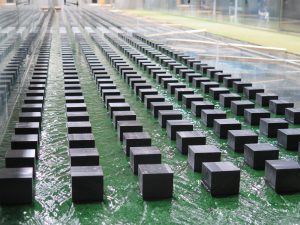 |
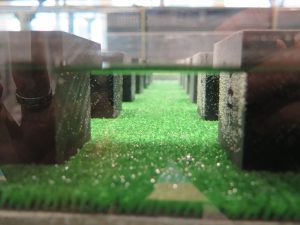 |
Projects
- ANR FlowRes project (2015-2018). ‘Predicting flows in floodplains with evolving land use during extreme flood events’.
Partners
- École Nationale Polytechnique d’Alger (ENPA)
- Laboratoire d’Hydraulique Saint-Venant (LHSV)
- National Institute of Technology (NIT) in Rourkela, India.
PhD theses and post-doctorates
- January 2013 – June 2016: PhD of Victor Dupuis entitled : ‘Experimental investigation of flows subjected to a longitudinal transition in hydraulic roughness in single and compound channels’. PhD Université de Lyon, École Doctorale ED162. Co-supervised by S. Proust, C. Berni, and A. Paquier (director)
- PhD of Meriem Chétibi (January 2016 – December 2019) entitled : ‘Turbulent flows in non-prismatic open-channels’ (co-directors : S. Benmamar, ENPA; S. Proust, Irstea)
- PhD of Marina Oukacine (January 2016 – Juin 2019): ‘Experimental and numerical study of flows through emerged and slightly submerged macro-roughness elements’. Co-directors: N. Goutal (EDF), et S. Proust.
- Post-doctorate of Marc Chatelain (March 2017 – august 2018) entitled ‘3D LES (Large Eddy Simulation) of flooplain flows in the presence of emergent and slightly submerged macro-roughness elements’. Supervised by S. Proust.
- PhD of Djnana Khuntia (2016-2020) entitled ‘Unsteady open-channel flows over a rough-bed with and without emergent rigid vegetation’, National Institute of Technology, Rourkela. Supervised by K. Khatua and S. Proust from March to September 2018.
Publications
- Dupuis, V., S. Proust, C. Berni, and A. Paquier (2016). Combined effects of bed friction and emergent cylinder drag in open channel flow, Environmental Fluid Mechanics, vol. 16, n° 6, p. 1173-1193, DOI: 10.1007/s10652-016-9471-2.
- Chetibi, M., Proust, S., Benmamar, S. (2020 ). Transverse surface waves in steady uniform and non-uniform flows through emergent and weakly submerged square cylinders.Journal of Hydraulic Research, vol. 58, n°4, p. 605-617, DOI: 10.1080/00221686.2019.1647885
- M. Oukacine, S. Proust, F. Larrarte, N. Goutal (2021). Experimental flows through an array of emerged or slightly submerged square cylinders over a rough bed. Scientific Data , Nature Publishing Group, 8 (1), 10.1038/s41597-020-00791-w.
- Chatelain, M., and S. Proust (2021). Open-channel flows through emergent rigid vegetation: effects of bed roughness and shallowness on the flow structure and surface waves. Physics of fluids 33(10). doi: 10.1063/5.0063288


